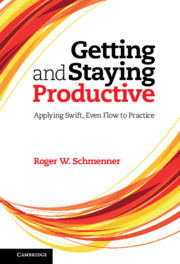Abernathy, W. J.Corcoran, J. E.Relearning from the Old Masters: Lessons of the American System of ManufacturingJournal of Operations Management 3 1983 155
Allen, R. C.The British Industrial Revolution in Global PerspectiveCambridge University Press 2009
Andras, P.Voth, H. J.Factor Prices and Productivity Growth During the British Industrial RevolutionExplorations in Economic History 40 2003 52
Banks, Banks. R. 1974
Bechler, Bechler.
Boorstin, D. J.The DiscoverersNew YorkVintage Books 1985
Broadberry, S. N.Comparative Productivity in British and American Manufacturing During the Nineteenth CenturyExplorations in Economic History 31 1994 521
Broadberry, S. N.Irwin, D. A.Labor Productivity in the United States and the United Kingdom During the Nineteenth CenturyExplorations in Economic History 43 2006 257
Brown, K. A.Hyer, N. L.Archeological Benchmarking: Fred Harvey and the Service Profit Chain, circa 1876Journal of Operations Management 25 2007 284
Chandler, A. D.The Visible HandCambridge, MABelknap Press 1977
Chandler, A. D.Scale and Scope: The Dynamics of Industrial CapitalismBostonBelknap Press 1990
Christensen, C. M.The Innovator’s Dilemma: When New Technologies Cause Great Firms to FailBostonHarvard Business School Press 1997
Clark, K. B.Fujimoto, T.Product Development Performance: Strategy, Organization, and Management in the World Auto IndustryBostonHarvard Business School Press 1991
Collins, Collins. R. 1985
Collins, Collins. R. 2002
Collins, R. S.Schmenner, R. W.Achieving Rigid Flexibility: Factory Focus for the 1990sEuropean Management Journal 11 1993 443
Collins, R. S.Schmenner, R. W.Understanding Persistently Variable Performance in PlantsInternational Journal of Operations and Production Management 27 2007 254
Finkelstein, Finkelstein.http://mba.tuck.dartmouth.edu/pages/faculty/syd.finkelstein/case_studies/01.html
Fisher, M.What is the Right Supply Chain for Your Product?Harvard Business Review 75 1997 105
Ford, H.Today And TomorrowNew YorkDoubleday, Page and Company 1926
Frei, F.Breaking the Trade-off Between Efficiency and ServiceHarvard Business Review 84 2006 92
Gilbreth, F. B.Motion Study: A Method for Increasing the Efficiency of the WorkmanNew YorkD. Van Nostrand 1910
Goldratt, Goldratt.Farnham, UKGower Publishing Ltd 2004
Gordon, Gordon. R.Does the ‘New Economy’ Measure up to the Great Inventions of the Past?Journal of Economic Perspectives 14 2000 49
Hall, Hall. R. 1991
Hall, R. W.Attaining Manufacturing ExcellenceNew YorkMcGraw-Hill 1987
Hall, R. W.CompressionNew YorkCRC Press 2010
Hammond, Hammond. J. 1994
Hayes, R. H.Wheelwright, S. C.Link Manufacturing Process and Product Life CyclesHarvard Business Review 57 1979 133
Hayes, R. H.Wheelwright, S. C.The Dynamics of Process–Product Life CyclesHarvard Business Review 57 1979 127
Heskett, Heskett. J. 1983
Hounshell, D. A.From the American System to Mass Production, 1800–1932BaltimoreJohns Hopkins University Press 1984
Johnson, Johnson. 2002
Juran, Juran. J.New YorkMcGraw-Hill Professional 2000
Krugman, P.The Age of Diminished Expectations: US Economic Policy in the 1980sCambridge, MAMIT Press 1992
Landes, D. S.Revolution in TimeBostonBelknap Press 1983
Landes, D. S.The Wealth and Poverty of Nations: Why Are Some So Rich and Others So Poor?New YorkW. W. Norton 1998
Lane, F. C.Venetian Ships and Shipbuilders of the RenaissanceBaltimoreJohns Hopkins University Press 1934
Lane, F. C.Venice, A Maritime RepublicBaltimoreJohns Hopkins University Press 1973
Lewin, K.Field Theory in Social Science; Selected Theoretical Papers,New YorkHarper & Row 1951
Mabert, V. A.Showalter, M.Logistics of the American Circus: The Golden AgeProduction and Inventory Management Journal 46 2010 74
Mabert, V. A.Muth, J. F.Schmenner, R. W.Collapsing New Product Development Times: Six Case StudiesJournal of Product Innovation Management 9 1992 200
Miller, J. G.Vollmann, T. E.The Hidden FactoryHarvard Business Review 63 1985 142
Mokyr, J.The Enlightened Economy, An Economic History of Britain 1700–1850New HavenYale University Press 2010
Morgan, Morgan. I. 1986
Morris, C. R.The TycoonsNew YorkHenry Holt and Company 2005
Ohno, T.Toyota Production System: Beyond Large-Scale ProductionNew YorkProductivity Press 1988
Omega, S. A. 1992
Pierson, Pierson. J. 2008
Pine, B. J.Davis, S.Mass Customization: The New Frontier in Business CompetitionBostonHarvard Business School Press 1993
Prahalad, C. K.Hamel, G.The Core Competence of the CorporationHarvard Business Review 68 1990 79
Reinertsen, D. G.The Principles of Product Development FlowRedondo BeachCeleritas Publishing 2009
Rose, AThe American RifleNew YorkRosewriter, Inc 2008
Schmenner, R. W.Making Business Location DecisionsEnglewood CliffsPrentice Hall 1982
Schmenner, R. W.Every Factory Has a Life CycleHarvard Business Review 61 1983 121
Schmenner, R. W.Escaping the Black Holes of Cost AccountingBusiness Horizons 31 1988 66
Schmenner, R. W.The Merit of Making Things FastSloan Management Review 30 1988 11
Schmenner, R. W.International Factory Productivity GainsJournal of Operations Management 10 1991 229
Schmenner, R. W.Looking Ahead by Looking Back: Swift, Even Flow in the History of ManufacturingProduction and Operations Management 10 2001 87
Schmenner, R. W. 1988
Schmenner, R. W. 1975
Schmenner, R. W.Service Businesses and ProductivityDecision Sciences 35 2004 333
Schmenner, R. W. 2002
Schmenner, R. W.Cook, R.Explaining Productivity Differences in North Carolina FactoriesJournal of Operations Management 5 1985 273
Schmenner, R. W.Lackey, C.‘Slash and Burn’ Doesn’t Kill Weeds: Other Ways to Downsize the Manufacturing OperationBusiness Horizons 37 1994 80
Schmenner, R. W.Rho, B. H.An International Comparison of Factory ProductivityInternational Journal of Operations and Production Management 10 1990 16
Schmenner, R. W.Swink, M.On Theory in Operations ManagementJournal of Operations Management 17 1998 97
Skinner, W.The Focused FactoryHarvard Business Review 52 1974 113
Skinner, W. 1967
Skinner, W.The Productivity ParadoxHarvard Business Review 64 1986 55
Solow, R.Technical Change and the Aggregate Production FunctionReview of Economics and Statistics 39 1957 312
Solow, R. 1987
Taylor, F. W.Principles of Scientific ManagementNew York and LondonHarper & Brothers 1911
Verlinden, Verlinden. M. 1999
Wellian, Wellian. 2008
Wyckoff, Wyckoff. 1976





